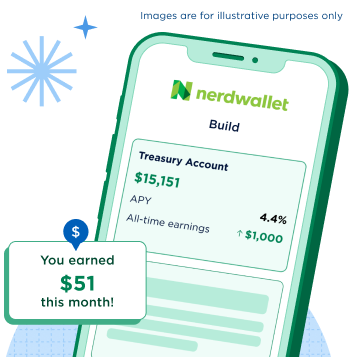How to Open a Roth IRA
Opening a Roth IRA is simple, but there are a few considerations to look into first, such as whether you're eligible, how you'll select your investments and how much you plan to contribute.

Many, or all, of the products featured on this page are from our advertising partners who compensate us when you take certain actions on our website or click to take an action on their website. However, this does not influence our evaluations. Our opinions are our own. Here is a list of our partners and here's how we make money.
The investing information provided on this page is for educational purposes only. NerdWallet, Inc. does not offer advisory or brokerage services, nor does it recommend or advise investors to buy or sell particular stocks, securities or other investments.
A Roth IRA is a true gift for retirement savers. Although you pay taxes upfront on the money you put into the account, both your contributions and earnings grow tax-free — and qualified withdrawals in retirement are tax-free, too. Roth IRAs also don't require minimum distributions, so you can choose to leave the money in the account to keep growing after you've retired.
Opening a Roth IRA is a strong first step toward supercharging your retirement savings. Here's how to get started:
Check if you're eligible
Choose where to open your account
Decide how much to invest
Sign up for the account
Select your investments
How to start a Roth IRA
1. Figure out if you are eligible to contribute to a Roth IRA.
While most people with earned income can open a Roth IRA, how much you can contribute is based on that year's income. For 2025, the contribution limit for a Roth IRA is $7,000 for those under age 50 and $8,000 for those age 50 and older. That contribution limit phases out and is eventually eliminated at higher incomes.
If you are not eligible for a Roth IRA because your modified adjusted gross income exceeds the allowed limits, consider the backdoor Roth IRA strategy, which lets you open a Roth by converting money from a traditional IRA.
2025 Roth IRA eligibility rules
2025 filing status | Annual Roth IRA income thresholds and phaseouts |
|---|---|
Single, head of household or married filing separately (if you didn't live with spouse during the year) | Full contribution: Less than $150,000. Partial contribution: Between $150,000 and $165,000. No Contribution: $165,000 or more. |
Married filing jointly or surviving spouse | Full contribution: Less than $236,000. Partial contribution: Between $236,000 and $246,000. No Contribution: $246,000 or more. |
Married filing separately (if you lived with spouse at any time during the year) | Partial contribution: Less than $10,000. No contribution: $10,000 or more. |
» Read our detailed overview of Roth IRA contribution and income limits
2. Decide where to open your IRA
If you're a “do-it-yourself” investor, open your Roth IRA at a brokerage.
For people who want to pick their own investments, opening a Roth IRA at an online broker makes a lot of sense. At the best brokers, you’ll find a large list of low-cost investments to choose from, including index funds and exchange-traded funds. The top brokers also offer extensive retirement planning tools, robust customer service and reasonable account minimums and fees. And you maintain complete control over how your retirement funds are invested.
If you're a “manage it for me” or hands-off investor, choose a robo-advisor.
If you’d rather have someone pick an investment portfolio for you, you can open your Roth IRA at a robo-advisor. Robo-advisors are online services that build and maintain a diversified portfolio for you. You pay a small fee for the service, but their fees are generally far lower than those of a human financial advisor.
For people who want to invest for retirement but don’t want to worry about managing their portfolio over time, a robo-advisor is an easy choice. The advisor will offer portfolios that vary based on the amount of risk you want to take, with “aggressive” ones for people who want a high percentage of their portfolio in stocks and “conservative” for people who seek a less volatile investment account.
» See our list of the best Roth IRA providers
NerdWallet rating 4.8 /5 | NerdWallet rating 5.0 /5 | NerdWallet rating 4.6 /5 |
Fees $0 per online equity trade | Fees $0 per trade | Fees 0% - 4% varies by type of transaction; other fees may apply |
Account minimum $0 | Account minimum $0 | Account minimum $0 |
Promotion None no promotion available at this time | Promotion None no promotion available at this time | Promotion Get $200 in crypto when you sign up. Terms Apply. |
3. Choose how much you want to invest
How much do you need to open a Roth IRA? While there generally isn’t a fee for opening a Roth IRA, there may be other costs and requirements depending on your provider and selected investments. A few brokers and robo-advisors — but not all — may require a minimum amount to open an account with them.
Think about your budget, your investing goals and how long you have to invest. If you want to max out your contribution for the year and you're eligible to contribute the full amount, that works out to about $583 per month in 2025, or $666 if you're over age 50.
» Roth IRA calculator: Find out how much your contributions could be worth
4. Gather your paperwork to open the account
So, you’ve learned all about how Roth IRAs work and even settled on a provider. Now what? It’s time to gather any paperwork or documentation you may need to set up your Roth IRA account.
Exact requirements may vary based on the financial institution, but generally, you may want to have the following information available during the sign-up process:
An ID (such as a state driver’s license or a passport) to confirm your identity, address, and date of birth.
A Social Security number or tax identification number.
Proof of employment, if applicable.
The name, addresses and dates of birth of any beneficiaries you’d like to add to the account.
The routing and/or account numbers for the bank or investment account you’ll use to fund your Roth IRA.
Once you have all that information handy, head to the provider's website to open your Roth IRA account.
Earn 4.44% APY by investing in U.S. Treasury Bills*
Maximize your cash by investing in low-risk, government-backed T-Bills. All the work is done for you — just make the deposit and watch your money grow.

5. Pick your investments
A Roth IRA is an account type, not an automatic investment. Contributing is just the first step. If you want to build wealth over time, you also need to invest that money.
If you're a hands-off investor and you've opted to open your Roth IRA at a robo-advisor, that service will choose a diversified investment portfolio for you. It will also manage that portfolio over time, investing future contributions and making sure your overall strategy is on track. (Robo-advisors generally are registered investment advisors operating under a similar structure to human investment advisors.)
If you've opened your Roth IRA at a brokerage firm, you can get that diversification on your own by building a portfolio out of index funds and ETFs. To do that, you’ll want to decide how much of your money to put toward riskier investments, such as stock funds, and how much you want to keep relatively safe in, for example, bond funds and cash. This mix is called your asset allocation.
IRAs give you access to a large pool of investment options. Once you’ve decided on your allocation, you can select specific funds to meet that. And if you get stuck? Use a model. Check out the portfolios used by robo-advisors (often displayed on their websites), then mimic them. Be sure to rebalance the investments as they shift out of the original allocation you decided on because you won’t have robo-advisors to do it for you.
» More guidance: How to invest your IRA
💡 Things to keep in mind when opening a Roth IRA
If you have a 401(k) plan that offers matching dollars, consider contributing enough to receive the match first before contributing to other types of retirement accounts, including a Roth IRA. This ensures that you make the most of your contributions and don't lose out on free money.
A Roth IRA is just one type of IRA. Another popular one is the traditional IRA, which offers an upfront tax break. Here's more on a Roth vs. traditional IRA to learn which one works best for your needs.
Roth IRA contributions are restricted by income limits, and contributing to a Roth IRA beyond the IRS limit for your income level could result in penalties. This is particularly true for those who receive bonuses or salary increases later in the year. It can be helpful to monitor contributions to a Roth IRA periodically, particularly if you've set up automatic transfers. If you have overcontributed, here's how to fix excess contributions to an IRA.
Frequently asked questions
Where is the best place to open a Roth IRA?
The best place to open a Roth IRA depends on your preference for investment options, ease of use, and cost. If you'd like a hands-off approach to investing, consider a robo-advisor. If you prefer to choose your own investments, we also have a complete guide to the best investments in your IRA.
Can I transfer a 401(k) to a Roth IRA?
Yes, you can transfer funds from a 401(k) to a Roth IRA. The steps you'll have to take depend on whether your 401(k) is a traditional or Roth account. If transferring from a traditional 401(k) to a Roth IRA, you'd first roll the money into a traditional IRA, then convert to a Roth. Additionally, as you are moving pretax dollars into a Roth, which takes after-tax dollars, deferred income taxes will be due. You can learn how it all works in our 401(k) rollover guide.
How much should I save for retirement?
There are lots of factors to consider here, including your income, desired retirement age, monthly expenses, health status and future Social Security benefit levels. Our retirement calculator can help you gauge whether you're saving enough to ensure a comfortable retirement.










